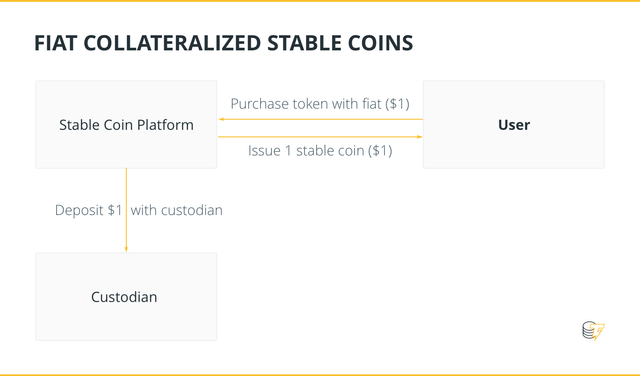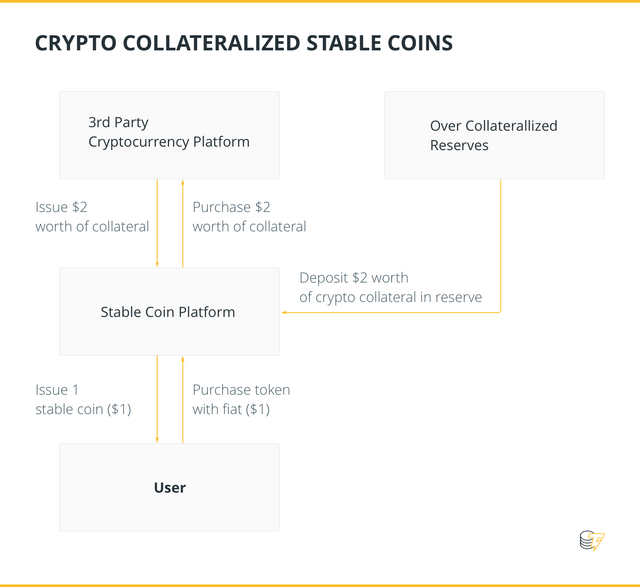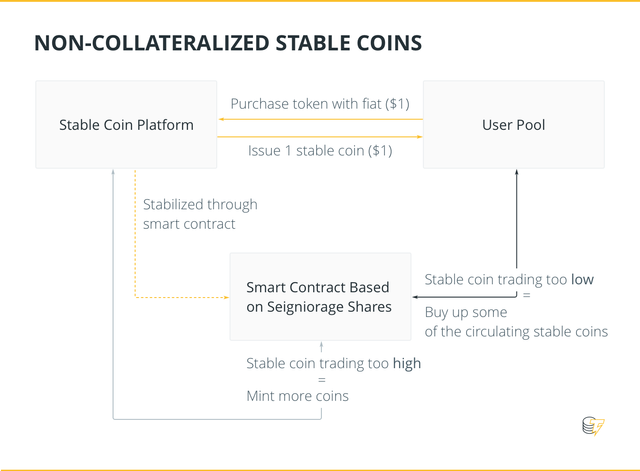Stable Coins Analysis: Is there a viable solution for the future?

The views and opinions expressed here are solely those of the author and do not necessarily reflect the views of Cointelegraph.com. This article does not contain investment advice or recommendations. Every investment and trading move involves risk, you should conduct your own research when making a decision.In a 2013 paper published by David Yernack, the professor of finance at New York University stated that, for any currency to be useful to society, it should be able to function as a medium of exchange, a store of value and a unit of account. At the time, he was using these three criteria to discredit Bitcoin as a feasible currency for everyday use. And there is some merit to this.Although popular cryptocurrencies can be used as a medium of exchange on a small scale and in certain ecosystems, it struggles as a store of value or a unit of account. The reason for this is the inherent instability of cryptocurrencies. Possible price fluctuations of 20% or more on any given day make it unsuited to comply with the latter two functions of a usable currency.To address this price volatility, a certain subset of cryptocurrencies started to emerge, i.e. stable coins. Being defined by Brigitte Luginbühl, CEO of SwissRealCoin:
“Unlike cryptocurrencies such as Bitcoin, which are highly volatile, stable coins provide people with the pragmatic, helpful benefits of a cryptocurrency, without having to worry about distressing price changes since they are grounded in the real world.”
A stable coin is designed to have a stable price or value over a period of time, therefore, less volatile.These coins aim to mimic the relative price stability of fiat currencies on one hand, but still keep the core values of cryptocurrencies such as decentralization and security, on the other hand.
Why do we need stable coins?
Without price stability, cryptocurrencies may struggle to achieve mass adoption, widespread circulation and, ultimately, everyday use.While volatility is fine for speculation, it’s not great for everyday payments. Nobody wants to be exposed to that sort of risk on a daily basis. Imagine your salary is paid exclusively in crypto. If the price of said crypto drops overnight by 20%, everything will have effectively become a fifth more expensive by the time you wake up the next morning.As Rafael Cosman, CEO of TrustToken puts it:
"Stable coins are one of the keys to bringing the benefits of cryptocurrencies to everyday people, both in terms of price stability and decentralization of capital.”
It’s not just for payments. Price stability is a fundamental requirement if you want to bring traditional financial products, such as loans and reliable savings options, onto the blockchain. So an ultimate goal of a functioning stable coin, which does not compromise on the key characteristics of a cryptocurrency, is to ease widespread adoption among everyday users.There are a number of so-called stable coins on the market trying to achieve this, with varying degrees of success. All of them will fall under one of three, broad categories:
- Fiat collateralized
- Crypto collateralized
- Non-collateralized
Fiat collateralized stable coins

This is perhaps the easiest to implement and functions like a basic IOU system. Each and every token is collateralized by an equal amount of fiat currency held by a central custodian (such as a bank). Holders are guaranteed to redeem their token at any point for the stable value denominated in fiat, say $1.Tether is perhaps the most famous example. For every issued Tether token (USDT), an equal amount of US dollars is deposited with a custodian, meaning Tether should always trade 1:1 (1USDT = 1USD). Despite the stable value, Tether has come under a lot of scrutiny. Many believe the token is not sufficiently collateralized and its issuance of hundreds of millions of new tokenswithout having its reserves being officially audited is only casting more doubt on the token’s validity.TrueUSD - built on top of the tokenization platform TrustToken - is another fiat collateralized token (pegged to USD), similar to Tether. As such it was received with some skepticism by the crypto community.However, in an effort to increase transparency, reserves are held in escrow accounts which offer daily auditing and legal protection for holders. The foundation platform, TrustToken, actually collaborated with different law firms (Cooley and WilmerHale) to develop a legal framework for TrueUSD.A similar concept but backed by a different asset is Digix. In an effort to create a stable coin, the token is collateralized by gold. Every DGX token is equal to 1 gram of 99.99% LBMA approved gold. It’s therefore stable in respect to 1 gram of gold, but as the value of gold can still fluctuate, the price of with respect to USD or any other fiat currency is not necessarily stable.Also, the gold standard is an outdated monetary system that was foregone in the US in the early 1970’s as the government realized that the production of gold could not keep up with the pace of growth of economies.There is also the first ever national, oil-backed token, Petro, launched by the Venezuelan government. Each Petro is backed by a barrel of Venezuelan crude oil, to a total issuing cost of $6 billion.However, many believe this to be an outright scam. Even Venezuela’s own congress declared the Petro token illegal with one legislature, Jorge Millan, commenting “This is not a cryptocurrency; this is a forward sale of Venezuelan oil. It is tailor-made for corruption.”Although fiat collateralized tokens (or commodity backed tokens for that matter) do bring a degree of stability, it’s unlikely to become an everyday token of choice for two main reasons.One, it’s not scalable – you will need fasts amounts of capital to serve as collateral if you want to mint enough tokens to have the ability of mass adoption (for example, the value of all the money on earth is around $90 trillion).And two, a central authority or custodian will have to be trusted with keeping the collateral (e.g. banks). This is counterintuitive as the possibility of a central influence is exactly what cryptocurrencies want to safeguard against.
Crypto collateralized stable coins

Crypto collateralized stable coins are backed by reserves of another cryptocurrency. This is done to address the centralization aspect of fiat collateralized tokens and achieve price stability in a completely decentralized ecosystem.The biggest flaw is quite obvious here: the coin is backed by a potentially equally unstable cryptocurrency. To counteract this, crypto collateralized coins are often over-collateralized to absorb price fluctuations with the excess reserves.The concept works by issuing one $1 dollar stable coin, you deposit $2 worth of the collateral coin. That means the stable coin is 200% collateralized, creating a lot of leeway should the collateral coin drop in value.Depositors of the chosen collateral would normally be incentivized to do so through interest payments.The first cryptocurrency to use this form of collateralization was BitShares, which uses their native network currency (bitshares) as collateral to create market pegged assets such as BitUSD, BitCNY and BitGold. These market pegged assets can then be traded like futures (derivative contracts) to effectively increase the collateral.Another coin that uses this mechanism is Dai, developed by MakerDAO. Dai is pegged to USD but collateralized by Ethereum. A Dai user could therefore generate the stable coin by locking up an excess amount of ETH in a smart contract. Smart contracts are completely autonomous and trustless environments which mean if the user wants to access their collateral, they simply have to pay back the Dai debt (no reliance on third-party institutions).Alternatively, the reserves will be sold automatically if the collateral dips below a specified threshold.On the other hand, Havven uses a dual token system to achieve stability. The Haven token acts as collateral for the Havven platform while the stable coin, nUSD, are issued against the value of the collateral. Stability is achieved through user incentives (network transaction fees) to stake Havven tokens as collateral for nUSDCrypto collateralized stable coins are more decentralized and more liquid than their fiat collateralized counterparts, but again, unlikely to work as a stable, everyday token.The reliance on a cryptocurrency as collateral makes them less stable and also requires over-collateralization (read huge amounts of capital) to absorb inevitable price fluctuations. But maybe more importantly, they rely on very complex mechanisms to ensure stability which is likely to scare off many potential users.
Non-collateralized stable coins

Non-collateralized stable coins aim to closely mimic fiat currencies by not having any asset-backed collateral. Instead, price stability is achieved through an approach called seigniorage shares, a processed that was conceived by Robert Sams, founder and CEO of Clearmatics Technologies LTD.Through this approach, smart contracts can be programmed to resemble a reserve bank, enabling it to increase and decrease the supply of money in order for the value to remain as close as possible to the value of a pegged asset, such as USD.It works on a foundational economic principle called supply and demand. If the coin is trading too high, the smart contract will mint more tokens to increase supply and therefore reduce the value of the coin.The excess profits now lying in the smart contract is called the seigniorage. If the coins are trading below its market pegged asset, it will buy up some of the circulating supply with the excess profits, therefore decreasing supply and increasing the value through excess demand.But if the seigniorage is too low to buy enough tokens to increase the value to an adequate level, shares can be issued which gives the holder rights to future seigniorage (excess profits in the smart contract).The biggest problem here is that if the token platform does not continue growing with new users, it will be impossible to maintain its market peg. There’s also only a specific limit of downward pressure such a system can take before investors lose faith in the coin’s ability to pay out future seigniorage shares.There are a number of stable coins using this concept with the most noteworthy being Basis (formerly known as Basecoin) and Saga.Basis will peg to the US dollar in the short term but eventually aims to peg to a consumer price index (CPI) as holders use the coin to purchase goods and services.Saga, on the other hand, will be backed by variable fractional reserves pegged to the International Monetary Fund's SDR (special drawing rights).Non-collateralized stable coins will be the most viable option as an “everyday-token”, purely because it mimics the stability mechanisms used by traditional reserve banks with fiat currencies, while still staying completely decentralized and independent.It’s not perfect though as it requires continual growth from the platform for the stability mechanisms to work. This, in turn, makes it particularly vulnerable to a crash in the overall market or decline in interest from investors. Achieving stability can also be a complex process and safety parameters for upward and downward pressure is difficult to determine with reasonable certainty.
How will stable coins work in the perfect future?
As Fran Strajnar, head of analysis firm, Brave New Coin, puts it:
“Stable coins are set to climb the ladder as some of the most in-demand crypto assets as the industry matures and more institutional participants enter the marketplace.”
We mentioned in the beginning that price stability is necessary to achieve cryptocurrency mass adoption and everyday use. So stable coins are deemed to be the future of cryptocurrencies and the perfect stable coin will use some variation of non-collateralized tokens.But in order to achieve this, platforms need to develop tokens with the potential to scale to global proportions while still being able to guarantee privacy. A completely transparent Blockchain ledger is not ideal to keep business interests and relationships safe.For truly decentralized stable coins to work, there must also be a system in place that can reliably obtain the exchange rate between the stable coin and the pegged asset, without leaning on third-party institutions that can be manipulated.At the moment, stable coins are seen as highly ambitious and highly experimental. As such, there is not one perfect stable coin out there with 100% successful implementation.But if we are to see the displacement of fiat currencies that contain damaging monetary policies, stable coins will be the way to get there. The ideal stable coin with robust stability mechanisms that can effectively deal with any price fluctuation and run on par with traditional fiat currencies, will undoubtedly signal the beginning of the end to hyperinflation, central government interference, fraud and mismanagement that most economies suffer from to some degree.
“Are stable-value assets necessary? Given the high level of interest in “blockchain technology” coupled with disinterest in “Bitcoin the currency” that we see among so many in the mainstream world, perhaps the time is ripe for stable-currency or multi-currency systems to take over.”
These are the words of Vitalik Buterin, Ethereum founder.